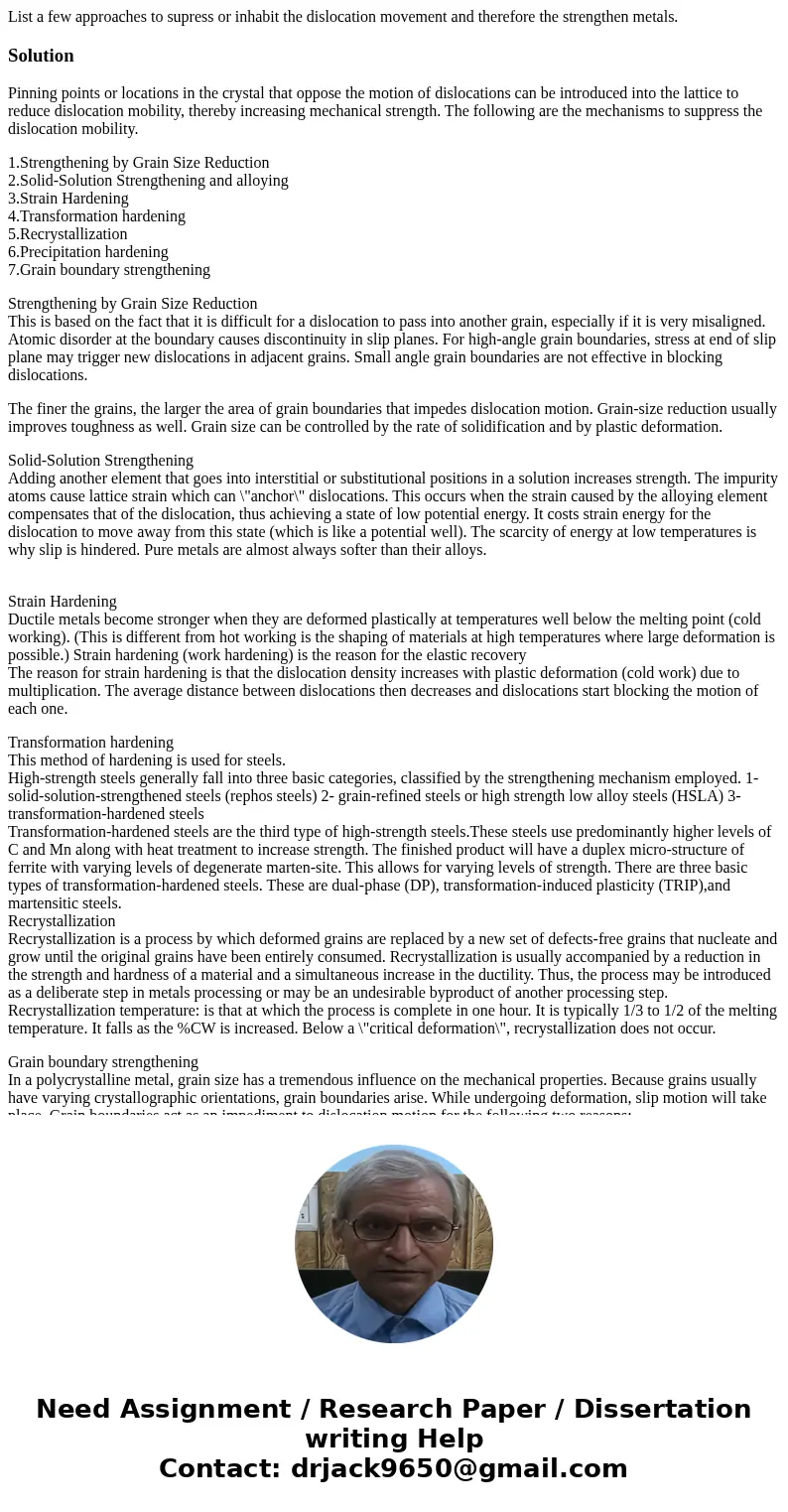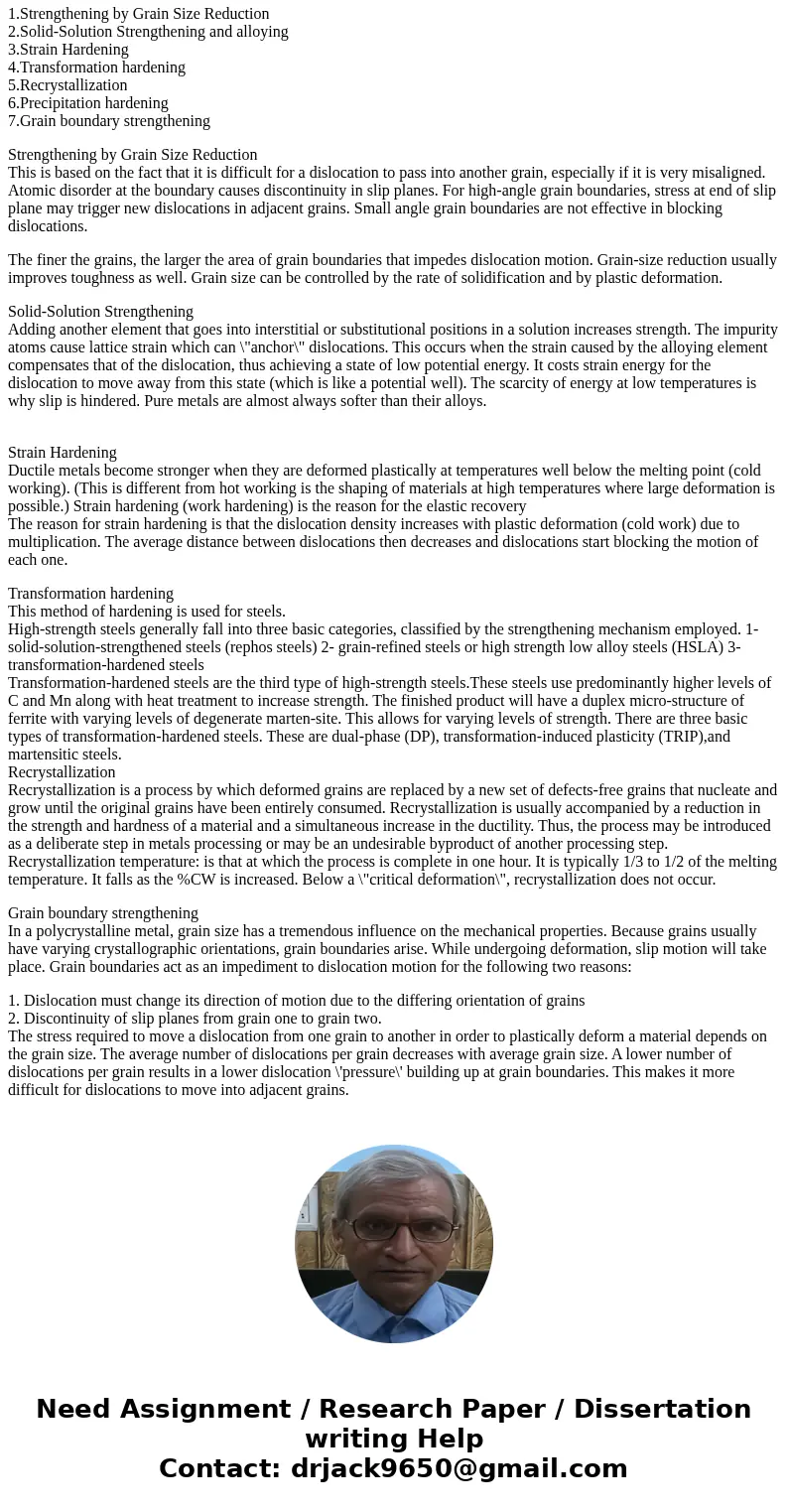List a few approaches to supress or inhabit the dislocation
List a few approaches to supress or inhabit the dislocation movement and therefore the strengthen metals.
Solution
Pinning points or locations in the crystal that oppose the motion of dislocations can be introduced into the lattice to reduce dislocation mobility, thereby increasing mechanical strength. The following are the mechanisms to suppress the dislocation mobility.
1.Strengthening by Grain Size Reduction
2.Solid-Solution Strengthening and alloying
3.Strain Hardening
4.Transformation hardening
5.Recrystallization
6.Precipitation hardening
7.Grain boundary strengthening
Strengthening by Grain Size Reduction
This is based on the fact that it is difficult for a dislocation to pass into another grain, especially if it is very misaligned. Atomic disorder at the boundary causes discontinuity in slip planes. For high-angle grain boundaries, stress at end of slip plane may trigger new dislocations in adjacent grains. Small angle grain boundaries are not effective in blocking dislocations.
The finer the grains, the larger the area of grain boundaries that impedes dislocation motion. Grain-size reduction usually improves toughness as well. Grain size can be controlled by the rate of solidification and by plastic deformation.
Solid-Solution Strengthening
Adding another element that goes into interstitial or substitutional positions in a solution increases strength. The impurity atoms cause lattice strain which can \"anchor\" dislocations. This occurs when the strain caused by the alloying element compensates that of the dislocation, thus achieving a state of low potential energy. It costs strain energy for the dislocation to move away from this state (which is like a potential well). The scarcity of energy at low temperatures is why slip is hindered. Pure metals are almost always softer than their alloys.
Strain Hardening
Ductile metals become stronger when they are deformed plastically at temperatures well below the melting point (cold working). (This is different from hot working is the shaping of materials at high temperatures where large deformation is possible.) Strain hardening (work hardening) is the reason for the elastic recovery
The reason for strain hardening is that the dislocation density increases with plastic deformation (cold work) due to multiplication. The average distance between dislocations then decreases and dislocations start blocking the motion of each one.
Transformation hardening
This method of hardening is used for steels.
High-strength steels generally fall into three basic categories, classified by the strengthening mechanism employed. 1- solid-solution-strengthened steels (rephos steels) 2- grain-refined steels or high strength low alloy steels (HSLA) 3- transformation-hardened steels
Transformation-hardened steels are the third type of high-strength steels.These steels use predominantly higher levels of C and Mn along with heat treatment to increase strength. The finished product will have a duplex micro-structure of ferrite with varying levels of degenerate marten-site. This allows for varying levels of strength. There are three basic types of transformation-hardened steels. These are dual-phase (DP), transformation-induced plasticity (TRIP),and martensitic steels.
Recrystallization
Recrystallization is a process by which deformed grains are replaced by a new set of defects-free grains that nucleate and grow until the original grains have been entirely consumed. Recrystallization is usually accompanied by a reduction in the strength and hardness of a material and a simultaneous increase in the ductility. Thus, the process may be introduced as a deliberate step in metals processing or may be an undesirable byproduct of another processing step.
Recrystallization temperature: is that at which the process is complete in one hour. It is typically 1/3 to 1/2 of the melting temperature. It falls as the %CW is increased. Below a \"critical deformation\", recrystallization does not occur.
Grain boundary strengthening
In a polycrystalline metal, grain size has a tremendous influence on the mechanical properties. Because grains usually have varying crystallographic orientations, grain boundaries arise. While undergoing deformation, slip motion will take place. Grain boundaries act as an impediment to dislocation motion for the following two reasons:
1. Dislocation must change its direction of motion due to the differing orientation of grains
2. Discontinuity of slip planes from grain one to grain two.
The stress required to move a dislocation from one grain to another in order to plastically deform a material depends on the grain size. The average number of dislocations per grain decreases with average grain size. A lower number of dislocations per grain results in a lower dislocation \'pressure\' building up at grain boundaries. This makes it more difficult for dislocations to move into adjacent grains.


 Homework Sourse
Homework Sourse